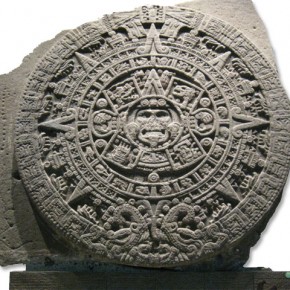The Aztecs were the last of the great cultures of Mesoamerica before the European conquests. They continued the traditions of the first of the Mesoamericans who looked into the heavens for ways to live in the good graces of their gods and the universe around them.
The Aztecs were an agricultural people that equated religion to survival. Aztec priests and leaders researched movements of the sun and planets in the sky. They followed a set of calendars to track planetary and solar events to make the most important decisions they had each year.
Aztec Sunstone Calendar
The Aztec Sunstone Calendar (or Calendar Stone) is a circular stone with pictures representing how the Aztecs measured days, months and cosmic cycles. The calendar is evidence of the Aztec’s knowledge of astronomy and mathematics. The calendar contains pictographs for their days, months and suns (cosmic cycles). The stone is 3.6 meters (12 feet) in diameter and weighs about 24 metric tons. It took 52 years to complete, from 1427-1479, it is believed due to the use of only stone tools. This calendar is 103 years older than the Gregorian calendar which is used worldwide today.
Originally the Calendar Stone was placed atop the main temple in Tenochtitlan, the capital of the Aztec empire. Today, Mexico City’s cathedral stands on the site. The Aztec calendar faced south in a vertical position and was painted a vibrant red, blue, yellow and white. The stone was buried by the Spaniards when they conquered Tenochtitlan. The stone was lost for over 250 years until December of 1790 when it was found by accident during repair work on the cathedral. Today it is located in the National Museum of Anthropology in Mexico City.
Calendar Stone Images and Representations
The face of Tonatiuh is in the center circle of the stone. Around the face are four squares called Nahui-Ollin, or Four Movement. According to Aztec legend, these squares represented the different ways that the four previous suns (or worlds) had come to an end: first by wild animals, then by wind, by fire and by floods. The Aztecs believed they were living in the fifth and last world.
Continuing outward, the next concentric circle shows twenty squares, each naming one of the twenty different days of the Aztec month. Clockwise these days are as follows:
Snake – Coatl
Lizard – Cuetzpallin
House – Calli
Wind – Ehecatl
Crocodile – Cipactli
Flower – Xochitl
Rain – Quiahuitl
Flint – Tecpatl
Movement – Ollin
Vulture – Cozcacuauhtli
Eagle – Cuauhtle
Jaguar – Ocelotl
Cane – Acatl
Herb – Malinalli
Monkey – Ozomatli
Hairless Dog – Itzquintli
Water – Atl
Rabbi – Tochtli
Deer – Mazatl
Skull – Miquiztli
The Aztec year consisted of 18 months, each having 20 days.
Each month was given a specific name. This arrangement took care of 360 days (18 x 20), to which five dots were added inside the circle. These dots, known as Nemontemi, were sacrificial days.
The next concentric circle is composed of square sections with five dots in each section, probably representing weeks of five days. Next there are eight angles dividing the stone in eight parts. These represent the sun’s rays placed according to the cardinal points.
On the lower portion of the stone, two enormous snakes encircle the stone and face each other. Their bodies are divided into sections containing the symbols for flames, elephant-like trunks and jaguar-like forelegs. It is believed that these sections are also records of fifty-two year cycles. A square is carved at the top of the calendar between the tails of the snakes. Inside the square the date 13 Acatl is carved. This corresponds to 1479, the year the calendar was finished.
Eight equally spaced holes appear on the very edge of the calendar. The Aztec placed horizontal sticks here and the shadows of the sticks would fall on the figures of the calendar; thus the stone also served as a sundial. The famous calendar stone is a brilliant combination of artistry and geometry. It reflects the Aztec understanding of time and space as wheels within wheels. The detailed surface of the stone combines the understanding of the gods the people had created over the centuries as well as their observations of the heavens.
There was more than one design for the Aztec calendars that dictated different aspects of their daily life.
Time was something that was not always just measured in minutes, hours and days to the Aztecs however they had different methods of tracking relative time for their society. The Xiuhpohualli (the counting of years) is one of these calendars as well as the Tonalpohualli (the counting of days) or thirteen- day period. Each of these was represented by a picture or image so that they could be recognized just as we recognize a clock or calendar.
Calendar 1
The Xiuhpohualli was the counting of the years. This calendar was kept on a 365-day solar count. This was also the agricultural and ceremonial calendar of the Aztec state. It was divided into 18 periods, with each period containing 20 days, called veintenas. This left five days that were not represented. These were called nemontemi. These were the five transition days between the old and the new year, and were considered days of nothing. This was a time of festivals. People came to the festivals with their best clothes on, and took part in singing and dancing. This is also when the priest would perform sacrifices, most of these sacrifices were human, but others were preformed on animals and fruit.
Calendar 2
The Tonalpohualli, considered the most sacred calendar, was the ‘counting of days.’ It originated by ancient peoples observing that the sun crossed a certain zenith point near the Mayan city of Copan, every 260 days. So this first system is arranged in a 260-day cycle. These 260 days were then broken up into 20 periods, with each period containing 13 days, called trecenas. Each period was given the name of something that was then shown by a hieroglyphic sign, and each trecena was given a number 1-13. Each trecena is also thought to have a god or deity presiding over each of the trecena. They kept these counts in tonalamatls, books made from bark paper. The Aztecs used this as a religious calendar. Priests used the calendar to determine luck days for such activities as sowing crops, building houses, and going to war.
Every 52 years the Tonalpohualli and the Xiuhpohualli calendars would align.
This marked what was known as a Mesoamerican century. Every one of these centuries was marked by Xiuhmolpilli, the Binding Up of the Years or the New Fire Ceremony. This was a festival that lasted twelve days and included fasting as a symbol of penitence. At the beginning of this festival all the lights in the city were extinguished – people let their hearth fires go out.
Then on midnight of the 12th day of the festival, a prisoner was taken to the priest. The priest would watch in the night sky for the star of fire to reach the zenith. Once it did, the priest would remove the heart of this man, and replace it with a piece of wood, that was laid on a piece of turquoise. This is where the priest would start the new fire that would once again light the city.
- Aztec Sunstone Calendar
- Aztec Calendar
- Calendar Stone, National Museum of Anthropology in Mexico City







